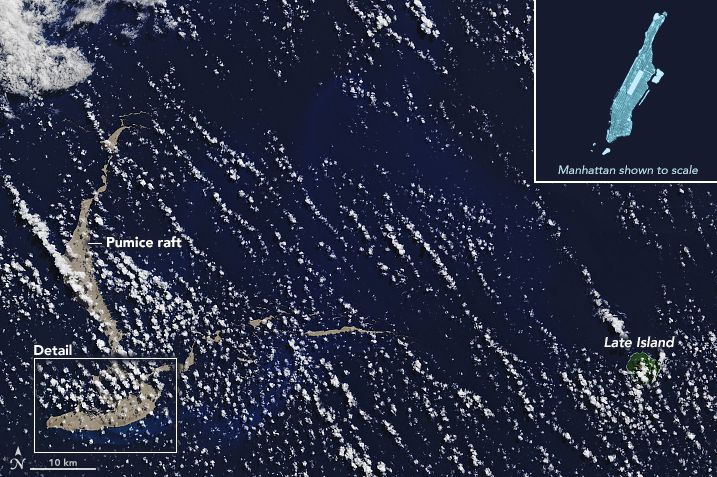A pumice stone deposit the size of Manhattan that emerged from underwater volcanoes last year has had both positive and negative effects on its local environment.
When molten lava erupts from underwater volcanoes, it is rapidly cooled and turned into the bubbly rock known as pumice. The stones can end up forming free-floating rafts that host microscopic organisms and tiny sea creatures.
“When they wash up, they are literally chock-a-block full of animals and plants,” Dr Eleanor Velasquez, who studies pumice rafts at Griffith University, told the ABC.
“The beauty of the pumice raft is that it gets washed around past all these different shallow marine reef systems and has the opportunity to pick up all of these hitch-hiking corals and oysters and barnacles,” she said.
According to Velasquez, goose barnacles reside on pumice soon after an eruption and can encourage more species to reside on the rocks.
“They tend to grow all on the same side of the pumice, and once there’s enough of them they act like the keel of a boat,” she said. “I believe that the goose barnacles actually promote more diversity on the pumice stones. Species that build habitat occur a lot in marine communities, and for the pumice rafts goose barnacles are one of those habitat-forming species.They actually create habitat rather than just simply occupying it and stopping other species from colonising.”
However, pumice can have a negative impact on the environment when transporting sea creatures to foreign ecosystems which can be damaging to ocean plants such as kelp.
In 2019, an underwater volcanic eruption near Fiji caused a giant pumice raft to form. Velazquez said it has affected inlets and bays, preventing locals in Fiji from fishing.
“It really causes distress for those communities because they are suddenly surrounded with this carpet of pumice that’s quite thick and there’s no way of really getting rid of it either, until the oceanic currents are suitable for it to be washed away,” she said.
“Whether pumice can provide some propagules [a vegetative structure that can become detached from a plant and give rise to a new plant] or introduce young corals to a damaged reef ecosystem is relatively new and untested.”
In quarrying, pumice is deposited on the surface of the earth in loose aggregate form and therefore blasting is unnecessary because it is unconsolidated and can be ripped up by dozers and excavator shovels. Scalping screens are used to filter the pumice from organic soils and unwanted rocks and crushers are used to achieve desired grades, including lump, coarse, intermediate, fine and extra fine.
As an end product, pumice has been employed for centuries in construction, medicine and the cosmetics industry. It is also used as an abrasive, especially in polishes, pencil erasers, and the production of stone-washed jeans. Pumice was also used in the early book making industry to prepare parchment paper and leather bindings. Today, there is still high demand for pumice, particularly for water filtration, chemical spill containment, cement manufacturing, horticulture and the pet industry.


